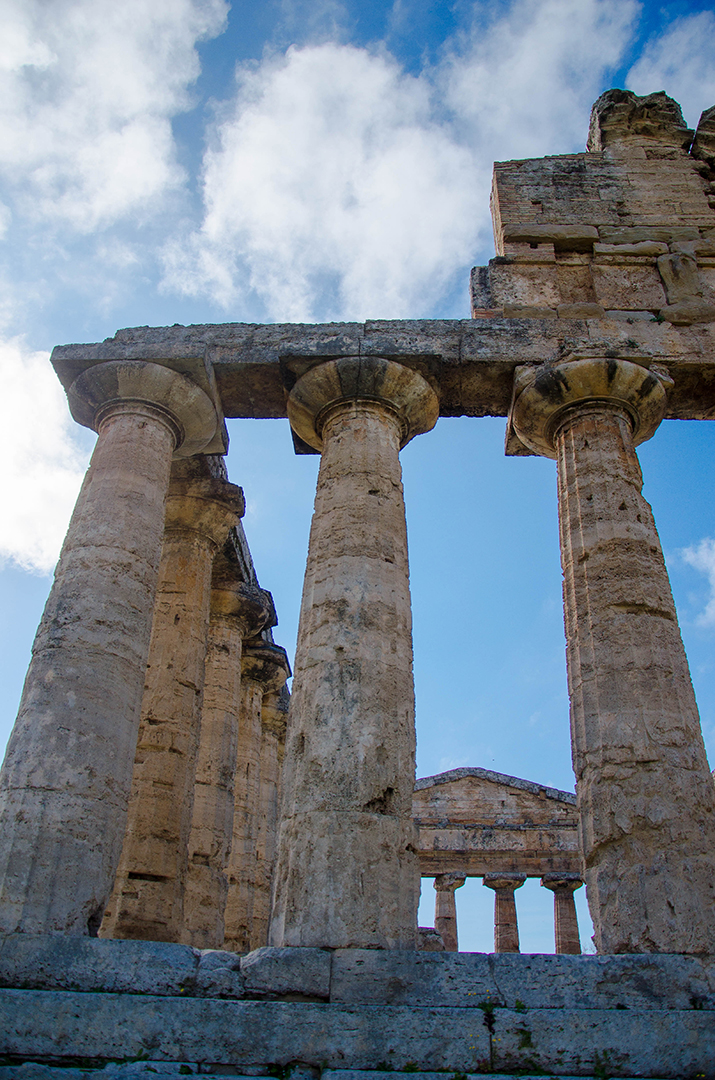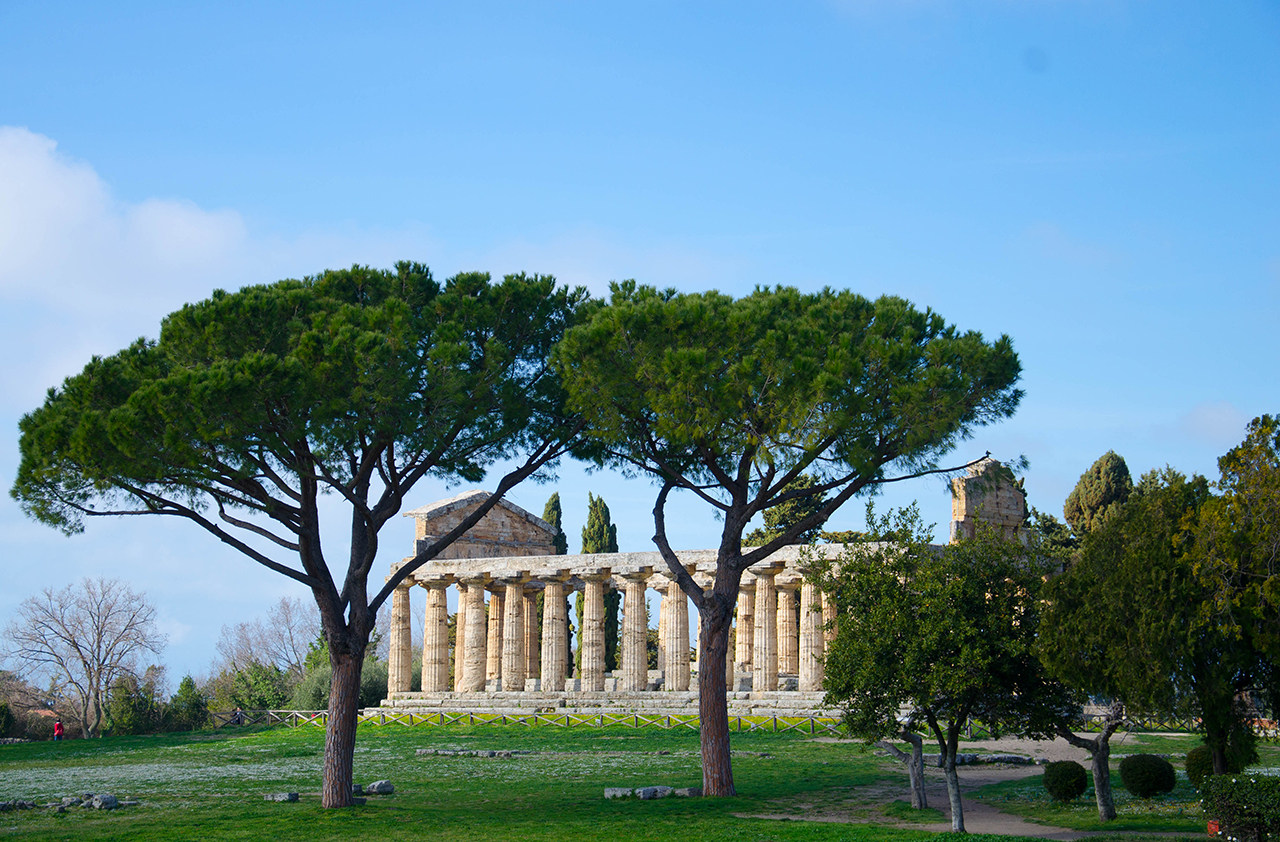Intro
Paestum is an ancient city located in southern Italy, in the region of Campania. It sits near the coast of the Tyrrhenian Sea, about 100 kilometers south of Naples. Today, Paestum is part of the modern town of Capaccio-Paestum. This beautiful area is known for its historic ruins, stunning landscapes, and peaceful countryside, making it a popular destination for tourists and history lovers.
Paestum was originally founded by Greek settlers around 600 BC and was first called Poseidonia, named after the god Poseidon. The Greeks built the city with strong walls, temples, and a planned layout. Over time, Paestum became a rich and important city. Its temples, especially the Temple of Hera and the Temple of Athena, are some of the best-preserved examples of ancient Greek architecture in the world.
Around 273 BC, the Romans took control of Paestum and changed the city’s name. Under Roman rule, the city continued to grow. They built new roads, a forum, an amphitheater, and bathhouses. The mix of Greek and Roman styles can still be seen in the ruins today. Paestum remained active through the Roman period but later declined as the area became marshy and hard to reach.
The city was forgotten for many centuries until it was rediscovered in the 18th century during road construction. Archaeologists began exploring the site, and it quickly became famous for its well-preserved temples. Today, Paestum is a UNESCO World Heritage Site and one of Italy’s top archaeological attractions. Visitors can walk through the ancient city, visit the museum, and admire the impressive ruins.
Paestum is not just a place of history—it is also a peaceful destination surrounded by nature, beaches, and charming local culture. Its combination of ancient ruins and modern beauty makes it a unique place to visit. Whether you love history, architecture, or simply want to explore a lesser-known part of Italy, Paestum offers a memorable experience.
The main archeological area and temples of Paestum
The archeological site
The archaeological site of Paestum covers an area of approximately 1.2 square kilometres. The main zone accessible to visitors is about 0.25 square kilometres. The ancient city is enclosed by strong defensive walls that are nearly 5,000 metres long and include well-preserved gates and towers. Visitors can explore paved streets, ancient homes, public buildings, and religious temples. Paestum is one of the largest and best-preserved archaeological sites in southern Italy, offering a rare and fascinating look at Greek and Roman city planning.
The main temples of Paestum
Paestum is best known for its three large and remarkably well-preserved ancient Greek temples. These temples were built between the 6th and 5th centuries BCE and are some of the oldest examples of Doric architecture in the world.
1. Temple of Hera (also called the Basilica)
This is the oldest temple at Paestum, built around 550 BCE. It was dedicated to Hera, the Greek goddess of family and marriage. The temple is about 24 metres wide and 55 metres long, with nine columns across the front and eighteen along the sides. Its strong stone columns and massive size show the power and skill of early Greek builders.
2. Temple of Athena (sometimes called the Temple of Ceres)
Located at the northern end of the site, this temple was built around 500 BCE. It was likely dedicated to Athena, the goddess of wisdom and war. The structure is smaller than the other temples, measuring about 14 metres wide and 32 metres long, but it features both Doric and Ionic styles. This mix shows the transition in Greek architecture during this period.
3. Second Temple of Hera (also called the Temple of Neptune or Poseidon)
Built around 460–450 BCE, this is the largest and most impressive temple in Paestum. It measures approximately 18 metres wide and 60 metres long. Although often called the Temple of Neptune, it was likely also dedicated to Hera. The structure remains almost completely intact, with all of its columns still standing, making it one of the best-preserved Greek temples in the world.
How to reach Paestum
Getting to Paestum is easy and convenient, especially if you're traveling from Naples or Salerno. Paestum is located about 100 kilometres south of Naples and about 40 kilometres south of Salerno, in the Campania region of southern Italy. You can reach Paestum by train, car, or bus, depending on your travel plans.
By Train: Fast and Direct
One of the best ways to get to Paestum is by train. From Naples Central Station, you can take a regional train or an Intercity train heading toward Agropoli or Sapri. The journey takes about 1 hour and 15 minutes to 1 hour and 30 minutes, depending on the train. From Salerno, the train ride is even shorter—about 35 to 45 minutes. Trains run several times a day, usually every hour or two, especially in the morning and afternoon. The Paestum train station is located just 1 kilometre from the archaeological site, and you can walk there in about 10 to 15 minutes.
By Car: A Scenic Drive
If you prefer to drive, Paestum is easy to reach by car. From Naples, take the A3 motorway south toward Salerno, then follow the signs for Battipaglia and continue on the SS18 highway to Paestum. The total driving time is about 1.5 to 2 hours, depending on traffic. There is parking available near the archaeological site. Driving gives you the flexibility to explore the surrounding area, including beaches, local farms, and nearby towns like Agropoli.
By Bus: A Budget Option
You can also reach Paestum by bus, although this option takes longer than the train. From Salerno, there are direct buses to Paestum that take about 1.5 to 2 hours, depending on stops and traffic. Buses may be less frequent than trains, especially outside the summer season, so it’s a good idea to check the timetable in advance. During the summer months, extra buses are often added for tourists.
Arriving and Visiting the Site
Once you arrive in Paestum, the archaeological park is easy to access on foot. The main entrance is well signposted, and the museum is located right next to the ruins. The site is open daily, usually from 8:30 in the morning until early evening, depending on the season. Make sure to check the official hours before your visit. Whether you come by train, car, or bus, Paestum is a peaceful and unforgettable stop on your journey through southern Italy.
Tips for your visit to Paestum
After exploring the stunning ruins of Paestum, make sure to take a break at one of the charming cafés near the archaeological site. Several cafés and restaurants in the area offer outdoor seating with direct views of the ancient Greek temples, making it the perfect spot to unwind. Enjoy a fresh Italian coffee, gelato, or a light lunch while admiring the impressive columns of the Temple of Hera or Athena in the background. This peaceful setting offers a unique chance to experience the history of Paestum while relaxing like a local.
Spring is one of the best times to visit Paestum, especially between March and May. During this season, the archaeological park is surrounded by blooming trees, wildflowers, and green fields, creating a beautiful and peaceful atmosphere. The pink and white blossoms around the ancient temples offer stunning photo opportunities and make your walk through the ruins even more enjoyable. With mild weather and fewer tourists, spring is ideal for a quiet and scenic visit to one of Italy’s most historic sites.
Before leaving, be sure to save time to visit the Paestum Archaeological Museum, located right next to the entrance of the ruins. The museum is home to important artifacts found on-site, including Greek and Roman pottery, statues, frescoes, and the famous Tomb of the Diver—a rare example of ancient Greek painting. Visiting the museum helps you understand the history of Paestum more deeply and brings the ancient city to life. Most visitors find that spending about 45 minutes to an hour in the museum completes the Paestum experience perfectly.
Outro
If you're staying anywhere along the Amalfi Coast, in Salerno, or even in Naples, a visit to Paestum is a wonderful way to spend part of your day. The site is easy to reach by train or car and gives you the chance to step into ancient history without the crowds. In just a few hours, you can explore the temples, walk through quiet ruins, and enjoy the peaceful atmosphere of one of Italy’s hidden gems.
Paestum is the perfect destination for a morning or afternoon trip. You can arrive in the morning, explore the temples, take a break at a café with a view, and still be back at your hotel by evening. If you prefer a slower pace, visit in the afternoon when the sunlight adds a golden glow to the ancient stones—great for photography and quiet walks. It’s a flexible, rewarding stop that fits easily into any southern Italy itinerary.
Whether you're exploring the Campania region, spending time along the coast, or planning a road trip through southern Italy, make sure to include Paestum on your list. Its stunning temples, open-air ruins, blooming landscapes in spring, and relaxing cafés make it a peaceful and unforgettable destination. Even a short visit to Paestum can become one of the most memorable parts of your Italian adventure.



























